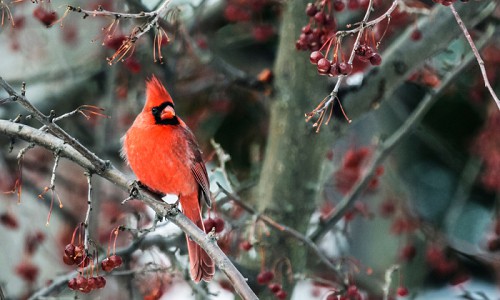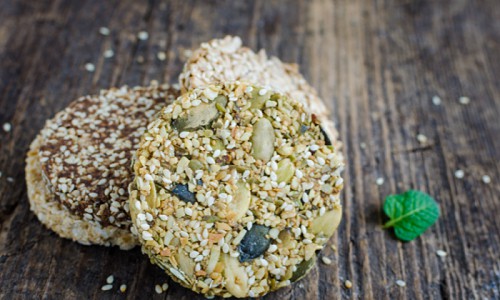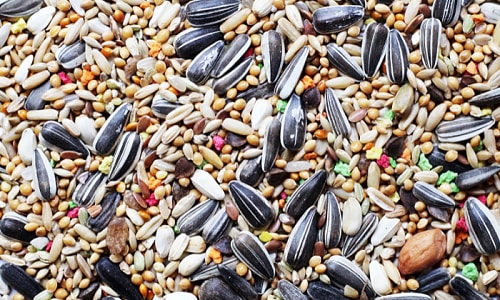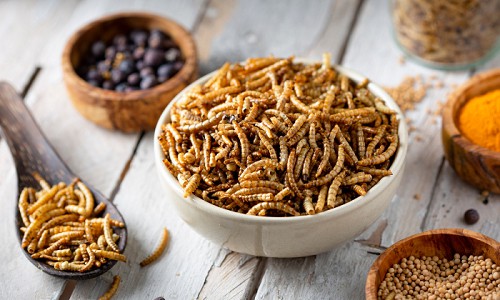Northern America and the Caribbean are often home to the cardinals. These birds don’t migrate during the winter, so if they can find enough food to eat in that particular place, they will never leave.
What do cardinals eat in the winter? The northern cardinals eat high-fat seeds, fruits, and insects during this season.
Keep reading to discover what food these amazing birds eat in the wintertime and how we may help them stay healthy.
Table of Contents
The Cardinal’s Winter Diet
Bird food for cardinals during the winter should contain a high level of fat and protein to help them combat the cold. Since they are omnivores, you can feed them various animal and plant foods.
Their cold-season food usually consists of the following:
1. Fruits
Cardinals love to eat fruits, but finding one during winter could be a challenge. When food is scarce, they tend to eat whatever they can find. Here are some of the foods they consume during winter:
- Staghorn sumac fruits – Rich in fat and protein, these red-colored fruits still sprout in wintertime, making them an important food source.
- Crabapple fruits – These small trees produce fruits during the fall and persist until the winter. Crabapples are also long-lasting; their only downside is that they provide little calorie.
- Juniper fruits – Juniper shrub grows in cold weather and is considered one of the best natural food sources for birds due to their aromatic taste and high vitamin content.
- American Holly berries – Sprouting in the winter, these dark red fruits are rich in calories. However, be sure to feed cardinals only a few berries at a time, as these berries are poisonous.
Aside from these winter-bearing fruits, you can feed cardinals fresh or dried apples, plums, blueberries, and cherries.
2. Suet
A homemade high-fat suet can help provide cardinals with the nutritional needs to survive the cold.
Based on how cold it gets, you can feed them suet made of pork fat, which contains 100% fat content. Alternatively, opt for suet cake made of lard and bird seeds, so the fat content can vary from 25% to 95% depending on how you mix them.
3. Seeds
Seeds—cardinals’ favorite food—are the perfect winter food for them. Again, you should pick those with a high amount of fat. Check the table below for some recommendations:
Seeds (Unseasoned)
Fat contents
Sunflower seeds
53.07%
Squash seeds
51.51%
Pumpkin seeds
51.51%
Nyjer seeds
35%
White milo
4%
4. Nuts
Aside from seeds, hulled and unsalted peanuts are the go-to food of cardinals. It is a perfect winter snack for the birds because it contains high caloric value of up to 45% fat and protein.
Other types of nuts cardinals eat are hickory nuts, acorns, cashews, walnuts, and almonds. Similar to peanuts, these should be unsalted and unseasoned to avoid disrupting the birds’ fluid and electrolyte balance, which can be potentially deadly.
5. Mealworms
Live and dried mealworms are also appetizing for cardinals and also a great resource of protein. Other invertebrates, such as caterpillars and centipedes, can also meet their nutritional needs to survive the winter.
6. Insects
Cardinals enjoy a broad range of insects like crickets, termites, ants, spiders, locusts, and beetles.
In addition, they feed on various kinds of flies and hoppers, such as sawflies, butterflies, grasshoppers, leafhoppers, or treehoppers.
Tips to Attract and Feed Cardinals
To attract northern cardinals in your yard, you must know how to feed cardinals in winter. Here are some tips to help cardinal feeders:
- Feed them during dusk and dawn, when their demand for calorie intake is the highest.
- Put the bird houses close to trees and away from reflective Cardinals want to have comfort and convenience while eating.
- Cardinals are rather heavy, so pick a large, sturdy feeder to support their weight.
- Your bird feed should include high-protein meals in addition to seeds. So be sure to mix mealworms and insects, which they can’t find in the wild during the winter, into their food.
- Keep water fresh and replace it occasionally to avoid freezing.
Conclusion
As winter comes, cardinals need to adapt their diet to the changing environment. Likewise, bird enthusiasts should know how cardinals survive winter and what they eat to help them through the cold season.
In our article, “what do cardinals eat in the winter?”, we’ve summed up all the food they need and tips to attract them. With this knowledge, you should be able to keep them well-fed and comfortable in the wintry weather.

George and I became friends after a birdwatching trip with our new group. And we have been enjoying every adventure together. When he told me the idea of establishing a site that shares our experiences and fun, I immediately agreed. After trials and errors, here we have Thayerbirding.




















